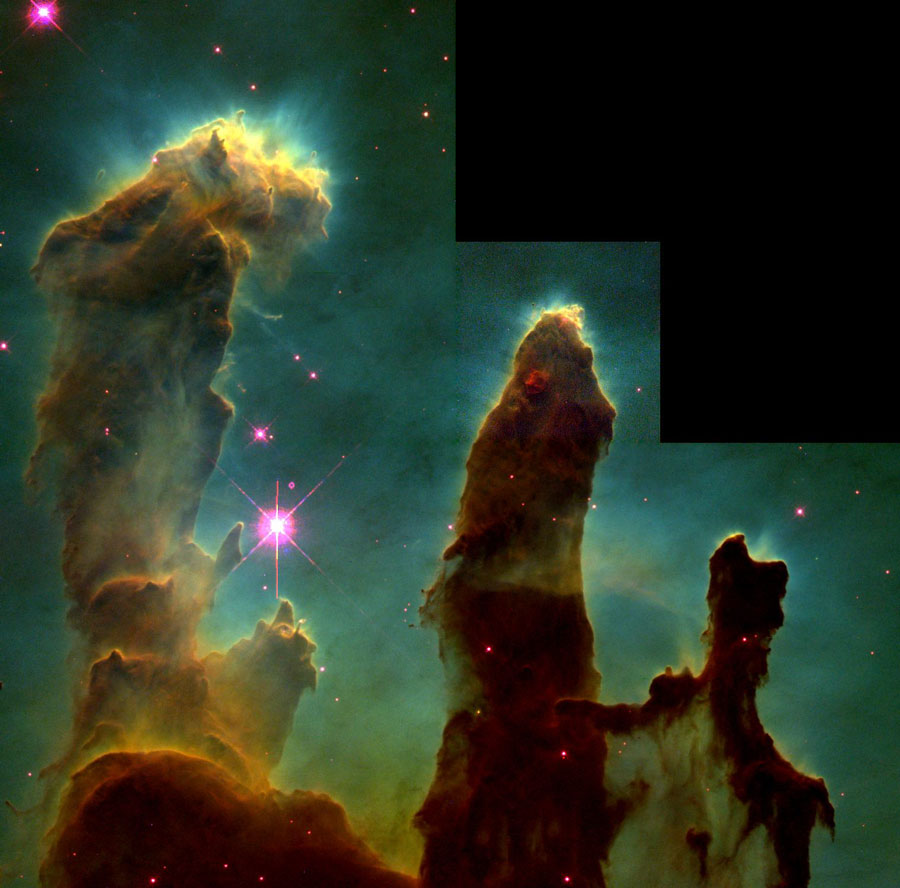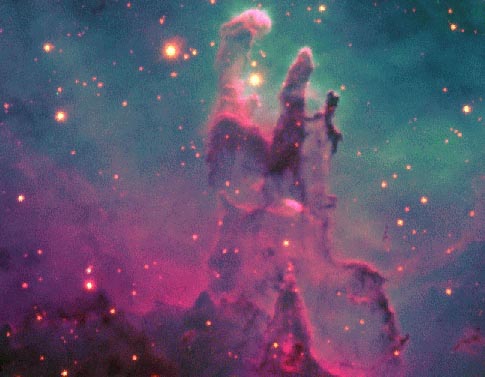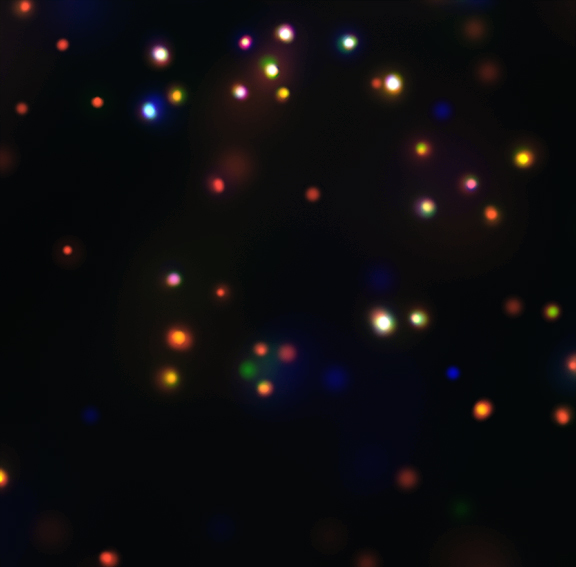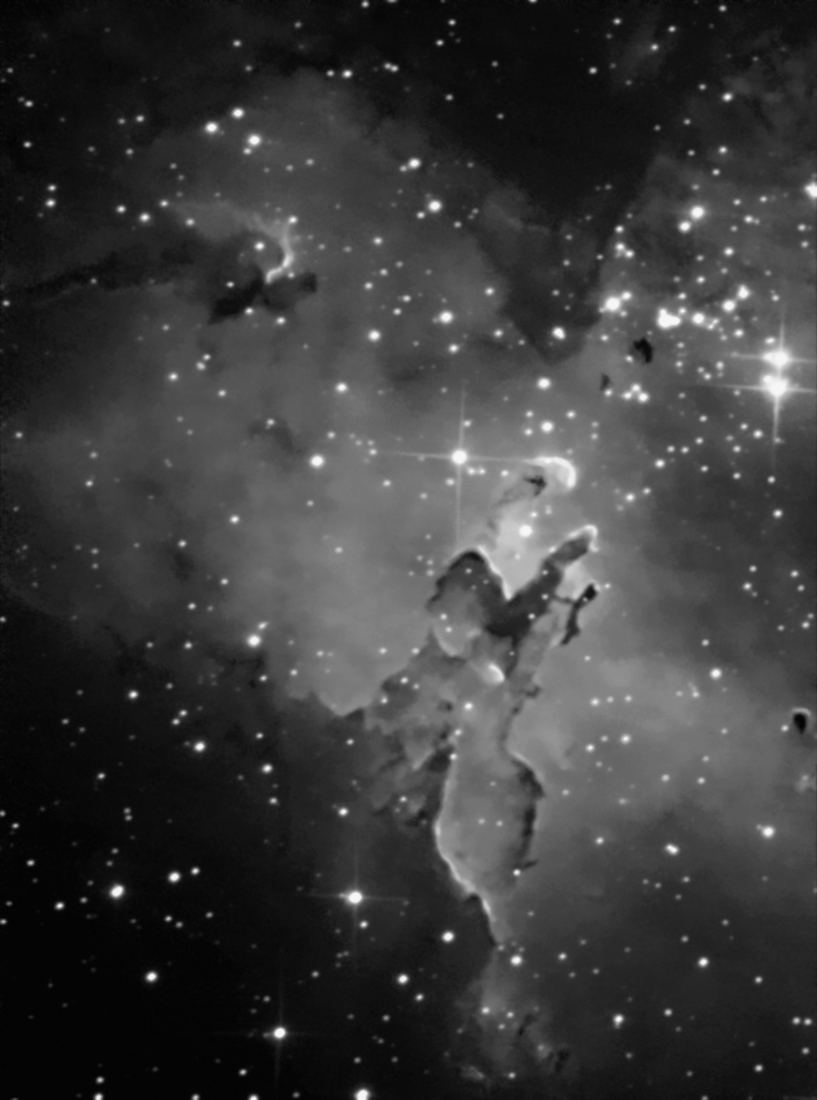The Pillars of Creation/Eagle Nebula Collection
Posted: Mon Jul 26, 2010 9:32 am
______________________________________________________________________________________
The pillars are famous, and deserved so. Here are different versions and images of these
well-known star factories and their nebula.
Please click on each image for best viewing; please click on the link associated with the
image for more information about the image and/or additional images.
Thank you!
______________________________________________________________________________________
The Famous Hubble Image
Credit: J. Hester, P. Scowen (ASU), HST, NASA It has become one of the most famous images of modern times. This image, taken with the Hubble Space Telescope in 1995, shows evaporating gaseous globules (EGGs) emerging from pillars of molecular hydrogen gas and dust. The giant pillars are light years in length and are so dense that interior gas contracts gravitationally to form stars. At each pillars' end, the intense radiation of bright young stars causes low density material to boil away, leaving stellar nurseries of dense EGGs exposed. The Eagle Nebula, associated with the open star cluster M16, lies about 7000 light years away. The pillars of creation were again imaged by the orbiting Chandra X-ray Observatory, and it was found that most EGGS are not strong emitters of X-rays.
APOD
Closer to Natural Colors
Credit: P. Challis (CfA), Whipple Obs., 1.2 m Telescope Bright blue stars are still forming in the red pillars of the Eagle Nebula. Made famous by a picture from the Hubble Space Telescope in 1995, the Eagle Nebula shows the dramatic process of star formation. To the upper right of the nebula in the above picture lies the heart of the open cluster M16. This picture closely depicts the true colors of the stars and nebula. The bright blue stars of M16 are continually forming from the Eagle Nebula gas, most recently in the famous gas and dust pillars seen below the photo's center. Of all the young stars in M16, the most massive shine the brightest and the bluest. A typical age for a star in this cluster is about 5 million years, making them only 1/1000 the age of our Sun. Light takes about 7000 years to reach us from M16.
APOD Composite Image
Credit: P. Challis (CfA), Whipple Obs., 1.2 m Telescope What lights up this castle of star formation? The familiar Eagle Nebula glows much like a neon sign, but in many colors at once. The above photograph is a composite of three of these glowing gas colors. In particular the glowing red Sulfur gas of the nebula nicely outlines some of the denser star forming knots. Energetic light from young massive stars causes the gas to glow and effectively boils away part of the dust and gas from its birth pillar. Many of these stars will explode after several million years, returning most of their elements back to the nebula which formed them. This process is forming an open cluster of stars known as M16.
APOD One Astrophotrographer, Four Versions
Credit and copyright: Paulo Lobao
In Infrared
Credit: NASA/JPL-Caltech/N. Flagey (IAS/SSC) & A. Noriega-Crespo (SSC/Caltech) In visible light, the whole thing looks like an eagle. The region was captured recently in unprecedented detail in infrared light by the robotic orbiting Spitzer Space Telescope (SSC). Shown above, the infrared image allows observers to peer through normally opaque dust and so better capture the full complexity of the Eagle Nebula star forming region. In particular, the three famous pillars near the image center are seen bathed in dust likely warmed by a supernova explosion. The warm dust is digitally assigned the false color of red. Also visible, near the bottom of the image, is ten light-year long pillar sometimes dubbed the Fairy of Eagle Nebula. The greater Eagle emission nebula, tagged M16, lies about 6500 light years away, spans about 20 light-years, and is visible with binoculars toward the constellation of Serpens.
APOD Widefield Image from Kitt Peal
Credit: T.A.Rector (NRAO/AUI/NSF and NOAO/AURA/NSF) and B.A.Wolpa (NOAO/AURA/NSF) This wide-field image of the Eagle Nebula was taken at the National Science Foundation's 0.9-meter telescope on Kitt Peak with the NOAO Mosaic CCD camera. Located in the constellation of Serpens, the Serpent, the Eagle Nebula is a very luminous open cluster of stars surrounded by dust and gas. The three pillars at the center of the image, made famous in an image by the Hubble Space Telescope, are being sculpted by the intense radiation from the hot stars in the cluster. This image was created by combining emission-line images in Hydrogen-alpha (green), Oxygen [O III] (blue) and Sulfur (red).
NOAO Near Infrared
Credit: ESO/M.McCaughrean & M.Andersen (AIP) Messier 16 (M16), also known as the Eagle Nebula, is located in the southern constellation of Serpens (the Snake).
Using the infrared multi-mode ISAAC instrument on the 8.2-m VLT ANTU telescope, European astronomers were able to image the Eagle Nebula at near-infrared wavelength. The ISAAC near-infrared images cover a 9 x 9 arcmin region, in three broad-band colours and with sufficient sensitivity to detect young stars of all masses and — most importantly — with an image sharpness as good as 0.35 arcsec.
The wide-field view of M16 shows that there is much happening in the region. The first impression one gets is of an enormous number of stars. Those which are blue in the infrared image are either members of the young NGC 6611 cluster — whose massive stars are concentrated in the upper right (north west) part of the field — or foreground stars which happen to lie along the line of sight towards M16.
Most of the stars are fainter and more yellow. They are ordinary stars behind M16, along the line of sight through the galactic bulge, and are seen through the molecular clouds out of which NGC 6611 formed. Some very red stars are also seen : these are either very young and embedded in gas and dust clouds, or just brighter stars in the background shining through them.
This photo is the result of a three-colour composite mosaic image of the Eagle Nebula (Messier 16), based on 144 individual images obtained with the infrared multi-mode instrument ISAAC on the ESO Very Large Telescope (VLT) at the Paranal Observatory. At the centre, the so-called "Pillars of Creation" can be seen. This wide-field infrared image shows not only the central three pillars but also several others in the same star-forming region, as well as a huge number of stars in front of, in, or behind the Eagle Nebula. The cluster of bright blue stars to the upper right is NGC 6611, home to the massive and hot stars that illuminate the pillars.
ESO X-Ray
Credit: NASA/CXC/U.Colorado/Linsky et al. A new look at the famous "Pillars of Creation" with NASA's Chandra X-ray Observatory has allowed astronomers to peer inside the dark columns of gas and dust. This penetrating view of the Eagle Nebula reveals how much star formation is happening inside these iconic structures.
Scale: Image is 2.5 arcmin across
Chandra Black and White
Copyright: Martin Germano A larger and more recent black and white image is available here.
Additional information
Hubble's Color Toolbox: Eagle Nebula
More information about this nebula
The pillars are famous, and deserved so. Here are different versions and images of these
well-known star factories and their nebula.
Please click on each image for best viewing; please click on the link associated with the
image for more information about the image and/or additional images.
Thank you!
______________________________________________________________________________________
The Famous Hubble Image
Credit: J. Hester, P. Scowen (ASU), HST, NASA It has become one of the most famous images of modern times. This image, taken with the Hubble Space Telescope in 1995, shows evaporating gaseous globules (EGGs) emerging from pillars of molecular hydrogen gas and dust. The giant pillars are light years in length and are so dense that interior gas contracts gravitationally to form stars. At each pillars' end, the intense radiation of bright young stars causes low density material to boil away, leaving stellar nurseries of dense EGGs exposed. The Eagle Nebula, associated with the open star cluster M16, lies about 7000 light years away. The pillars of creation were again imaged by the orbiting Chandra X-ray Observatory, and it was found that most EGGS are not strong emitters of X-rays.
APOD
| How to Find the Eagle Nebula |
Credit: P. Challis (CfA), Whipple Obs., 1.2 m Telescope Bright blue stars are still forming in the red pillars of the Eagle Nebula. Made famous by a picture from the Hubble Space Telescope in 1995, the Eagle Nebula shows the dramatic process of star formation. To the upper right of the nebula in the above picture lies the heart of the open cluster M16. This picture closely depicts the true colors of the stars and nebula. The bright blue stars of M16 are continually forming from the Eagle Nebula gas, most recently in the famous gas and dust pillars seen below the photo's center. Of all the young stars in M16, the most massive shine the brightest and the bluest. A typical age for a star in this cluster is about 5 million years, making them only 1/1000 the age of our Sun. Light takes about 7000 years to reach us from M16.
APOD Composite Image
Credit: P. Challis (CfA), Whipple Obs., 1.2 m Telescope What lights up this castle of star formation? The familiar Eagle Nebula glows much like a neon sign, but in many colors at once. The above photograph is a composite of three of these glowing gas colors. In particular the glowing red Sulfur gas of the nebula nicely outlines some of the denser star forming knots. Energetic light from young massive stars causes the gas to glow and effectively boils away part of the dust and gas from its birth pillar. Many of these stars will explode after several million years, returning most of their elements back to the nebula which formed them. This process is forming an open cluster of stars known as M16.
APOD One Astrophotrographer, Four Versions
Credit and copyright: Paulo Lobao
| [attachment=3]M16 - version a.jpg[/attachment][/i] | [attachment=2]M16 - version b.jpg[/attachment][/i] |
| [attachment=1]M16 - version c.jpg[/attachment][/i] | [attachment=0]M16 - version d.jpg[/attachment][/i] |
Credit: NASA/JPL-Caltech/N. Flagey (IAS/SSC) & A. Noriega-Crespo (SSC/Caltech) In visible light, the whole thing looks like an eagle. The region was captured recently in unprecedented detail in infrared light by the robotic orbiting Spitzer Space Telescope (SSC). Shown above, the infrared image allows observers to peer through normally opaque dust and so better capture the full complexity of the Eagle Nebula star forming region. In particular, the three famous pillars near the image center are seen bathed in dust likely warmed by a supernova explosion. The warm dust is digitally assigned the false color of red. Also visible, near the bottom of the image, is ten light-year long pillar sometimes dubbed the Fairy of Eagle Nebula. The greater Eagle emission nebula, tagged M16, lies about 6500 light years away, spans about 20 light-years, and is visible with binoculars toward the constellation of Serpens.
APOD Widefield Image from Kitt Peal
Credit: T.A.Rector (NRAO/AUI/NSF and NOAO/AURA/NSF) and B.A.Wolpa (NOAO/AURA/NSF) This wide-field image of the Eagle Nebula was taken at the National Science Foundation's 0.9-meter telescope on Kitt Peak with the NOAO Mosaic CCD camera. Located in the constellation of Serpens, the Serpent, the Eagle Nebula is a very luminous open cluster of stars surrounded by dust and gas. The three pillars at the center of the image, made famous in an image by the Hubble Space Telescope, are being sculpted by the intense radiation from the hot stars in the cluster. This image was created by combining emission-line images in Hydrogen-alpha (green), Oxygen [O III] (blue) and Sulfur (red).
NOAO Near Infrared
Credit: ESO/M.McCaughrean & M.Andersen (AIP) Messier 16 (M16), also known as the Eagle Nebula, is located in the southern constellation of Serpens (the Snake).
Using the infrared multi-mode ISAAC instrument on the 8.2-m VLT ANTU telescope, European astronomers were able to image the Eagle Nebula at near-infrared wavelength. The ISAAC near-infrared images cover a 9 x 9 arcmin region, in three broad-band colours and with sufficient sensitivity to detect young stars of all masses and — most importantly — with an image sharpness as good as 0.35 arcsec.
The wide-field view of M16 shows that there is much happening in the region. The first impression one gets is of an enormous number of stars. Those which are blue in the infrared image are either members of the young NGC 6611 cluster — whose massive stars are concentrated in the upper right (north west) part of the field — or foreground stars which happen to lie along the line of sight towards M16.
Most of the stars are fainter and more yellow. They are ordinary stars behind M16, along the line of sight through the galactic bulge, and are seen through the molecular clouds out of which NGC 6611 formed. Some very red stars are also seen : these are either very young and embedded in gas and dust clouds, or just brighter stars in the background shining through them.
This photo is the result of a three-colour composite mosaic image of the Eagle Nebula (Messier 16), based on 144 individual images obtained with the infrared multi-mode instrument ISAAC on the ESO Very Large Telescope (VLT) at the Paranal Observatory. At the centre, the so-called "Pillars of Creation" can be seen. This wide-field infrared image shows not only the central three pillars but also several others in the same star-forming region, as well as a huge number of stars in front of, in, or behind the Eagle Nebula. The cluster of bright blue stars to the upper right is NGC 6611, home to the massive and hot stars that illuminate the pillars.
ESO X-Ray
Credit: NASA/CXC/U.Colorado/Linsky et al. A new look at the famous "Pillars of Creation" with NASA's Chandra X-ray Observatory has allowed astronomers to peer inside the dark columns of gas and dust. This penetrating view of the Eagle Nebula reveals how much star formation is happening inside these iconic structures.
Scale: Image is 2.5 arcmin across
Chandra Black and White
Copyright: Martin Germano A larger and more recent black and white image is available here.
Additional information
Hubble's Color Toolbox: Eagle Nebula
More information about this nebula











